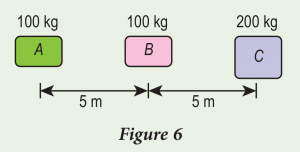Question 10:
Figure 6 shows three bodies A, B and C. It is given that the gravitational force between A and B is P.

State in terms of P, the gravitational force between
(i) B and C
(ii) A and C
Answer:
Between A and B : $$ \begin{aligned} F_{\mathrm{AB}} & =\frac{G m_1 m_2}{r^2} \\ P & =\frac{G \times 100 \times 100}{5^2} \\ P & =400 G \ldots \ldots[1] \end{aligned} $$
(i)
$$ \begin{array}{ll} \text { Between } B \text { and } C: & F_{B C}=\frac{G \times 100 \times 200}{5^2} \\ & F_{B C}=800 G \ldots \ldots[2] \\ \text { Compare [1] and [2], } & F_{B C}=2(400 G) \\ & F_{B C}=2 P \end{array} $$
(ii)
$$ \begin{array}{ll} \text { Between } A \text { and } C: & F_{A C}=\frac{G \times 100 \times 200}{10^2} \\ & F_{A C}=200 G \ldots \ldots[3] \\ \text { Compare [1] and [3], } & F_{A C}=0.5(400 G) \\ & F_{A C}=0.5 P \end{array} $$
Figure 6 shows three bodies A, B and C. It is given that the gravitational force between A and B is P.

State in terms of P, the gravitational force between
(i) B and C
(ii) A and C
Answer:
Between A and B : $$ \begin{aligned} F_{\mathrm{AB}} & =\frac{G m_1 m_2}{r^2} \\ P & =\frac{G \times 100 \times 100}{5^2} \\ P & =400 G \ldots \ldots[1] \end{aligned} $$
(i)
$$ \begin{array}{ll} \text { Between } B \text { and } C: & F_{B C}=\frac{G \times 100 \times 200}{5^2} \\ & F_{B C}=800 G \ldots \ldots[2] \\ \text { Compare [1] and [2], } & F_{B C}=2(400 G) \\ & F_{B C}=2 P \end{array} $$
(ii)
$$ \begin{array}{ll} \text { Between } A \text { and } C: & F_{A C}=\frac{G \times 100 \times 200}{10^2} \\ & F_{A C}=200 G \ldots \ldots[3] \\ \text { Compare [1] and [3], } & F_{A C}=0.5(400 G) \\ & F_{A C}=0.5 P \end{array} $$
Question 11:
Table 1 shows information on three types of orbits X, Y and Z for a satellite orbiting the Earth.

A space agency wishes to launch two satellites, P and Q to orbit the Earth. Satellite P is an Earth imaging satellite that can capture images of various locations on the surface of the Earth while satellite Q is a communication satellite.
Using the information in Table 1, determine which orbit is suitable for satellite P and satellite Q. Explain your choice.
Answer:
Satellite P is an imaging satellite with the following features:
(i) Orbital height is small so that clear photographs can be taken of the surface of the Earth.
(ii) Orbital period is less than 24 hours so that it can orbit the Earth several times a day. The satellite will be at different locations above the surface of the Earth and can take photographs in many different places.
(iii) Elliptical shaped orbit so that near and far photographs can be taken.
Therefore, satellite P needs to be placed in orbit X.
Satellite Q is a communication satellite with the following features:
(i) Orbital period of 24 hours so as to rotate together with the Earth and maintain at the same location above the surface of the Earth. This satellite can receive and transmit communication signals to stations on Earth.
(ii) Round orbit so that its height from the surface of the Earth is constant.
Therefore, satellite Q needs to be placed in orbit Y.
Table 1 shows information on three types of orbits X, Y and Z for a satellite orbiting the Earth.

A space agency wishes to launch two satellites, P and Q to orbit the Earth. Satellite P is an Earth imaging satellite that can capture images of various locations on the surface of the Earth while satellite Q is a communication satellite.
Using the information in Table 1, determine which orbit is suitable for satellite P and satellite Q. Explain your choice.
Answer:
Satellite P is an imaging satellite with the following features:
(i) Orbital height is small so that clear photographs can be taken of the surface of the Earth.
(ii) Orbital period is less than 24 hours so that it can orbit the Earth several times a day. The satellite will be at different locations above the surface of the Earth and can take photographs in many different places.
(iii) Elliptical shaped orbit so that near and far photographs can be taken.
Therefore, satellite P needs to be placed in orbit X.
Satellite Q is a communication satellite with the following features:
(i) Orbital period of 24 hours so as to rotate together with the Earth and maintain at the same location above the surface of the Earth. This satellite can receive and transmit communication signals to stations on Earth.
(ii) Round orbit so that its height from the surface of the Earth is constant.
Therefore, satellite Q needs to be placed in orbit Y.
